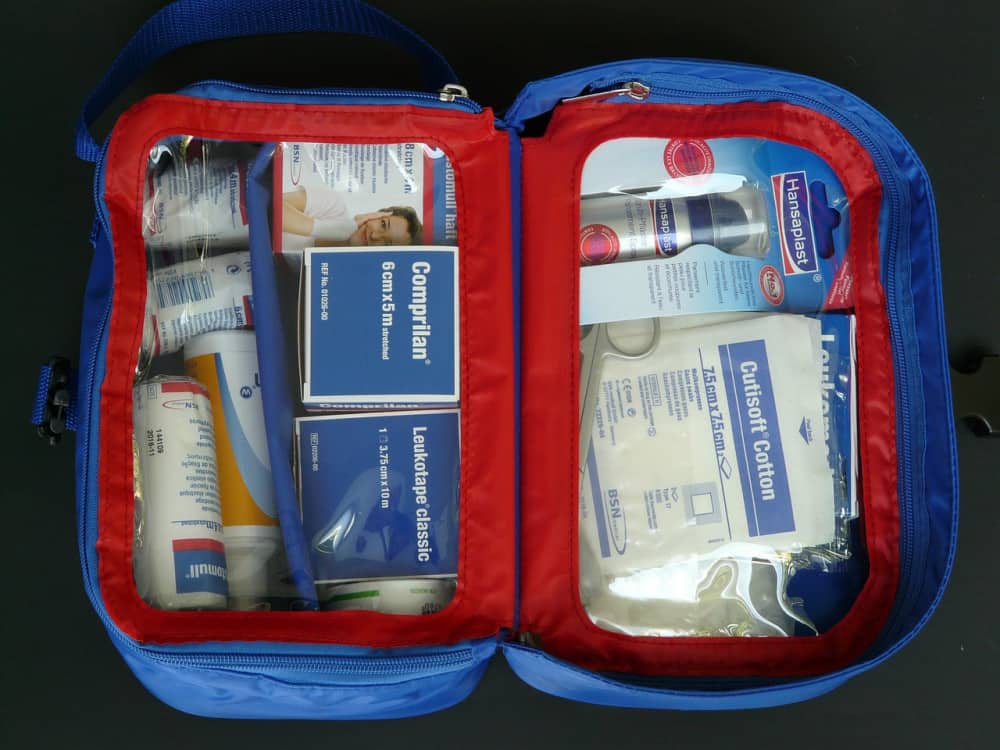The number one rule for caving is ‘come prepared’. A solid emergency kit is essential to your caving gear. But what should be in it? Let’s explore a little.
What’s in the perfect survival kit for caving? You need a basic first aid kit, that contains aspirin, plasters, and bandages. I always bring a bottle of water and some high-calorie nutrition bars. I also bring a garbage bag, a waterproof source of fire (like waterproof matches), and an 8-hour candle for warmth.
But you don’t want your emergency kit weighing you down, so it’s important to prioritize and bring only the most important items.
I’ll first tell you what’s in mine, and why. I’ve included a simple checklist, which you can hopefully use as a blueprint.
What’s in the Perfect Caving Kit?
The saying goes: the more gear you carry around, the more likely you’ll need it. I like to travel light and keep my energy high.
To create the perfect emergency kit, you should consider:
- What are the trip requirements?
- Will you be able to improvise?
- If not, bring it
A good survival kit contains a couple of simple things and definitely nothing in excess.
- small bottle of water
- 2-3 high density chocolate/food bars
- very basic first aid kit
- 2 spare flashlights
- plenty of spare batteries
- 8-hour candle
- survival bag – heavy duty plastic, orange color
- gaffer tape for fixing up boots and clothes and general improvisation
- LifeStraw water filter – (I use this one from Amazon)
- Petzl Spatha (click to check the current price on Amazon) – great, simple knife you can carry on your harness or belt
Some people also carry:
- compass and whistle
- climbing rope and other climbing equipment
In my opinion, you need a very basic first aid kit. Nothing fancy, because if you really need to patch someone up, a first aid kit won’t do much good anyways.
You also want to carry some food and water. To save weight, I choose to carry less water and carry a water filter instead. For food, I use high-calorie nutritional bars, like Twenny Bars. They’re one meal’s worth of nutrition. Three of those will get me through anything.
Caving rule no. 2: bring plenty of light. So I carry two spare flashlights and a lot of spare batteries.
To keep me warm, I use an 8-hour candle and a survival bag. I use them to create a Palmer Furnace. You pull the bag over your head and heat up the space using the candle – quite neat. It creates a hot air balloon. I carry waterproof matches inside a waterproof bag to light the candle.
I want to add that I don’t bring everything to every trip. Instead, I think about what conditions I might encounter. If the cave definitely doesn’t contain water, there’s no need to bring the filter.
How to Carry It
Some grottos prefer to do it military style. They each carry some of the basics and then carry a supplementary group kit with additionals (like the water filter and candle).
I wanted to bring everything myself.
A lot of cavers carry the first aid kit in a ziplock back under their helmet. I don’t do that, because it reduces the protection with rockfall. I bring the first aid kit to save me, not kill me!
I carry the first aid kit and matches inside the Peli Micro Case. These cases are perfect for important stuff that needs to stay dry and in one piece. These cases are just perfect for keeping things safe. They are waterproof and crushproof – and overall great for caving.
I use the 1010, which is the smallest of the bunch. It fits in some coverall pockets, and you can also clip it on your belt. It’s 5.88″ long, 4.06″ wide, and 2.12″ deep (or 14.9 x 10.3 x 5.4 cm).
They also look amazing. If you don’t know Pelican Cases, I definitely encourage you to check them out. Check out the one I have on Amazon here.
If you want something that can protect your phone, you need a size larger, like the 1040.
You could also slip a ziplock bag inside your wellie.
The spare lights and water and food in my coverall pockets, and the gaffer tape on my belt. I find I don’t really need a tacklesack.
To figure out what to bring and what to leave at home, you need to set some priorities first. I’ll go into my considerations below, which will hopefully help you to create your ultimate emergency kit.
What’s the Emergency Kit Actually For?
Let’s focus on why you want a survival kit in the first place. It’s then easy to think of what needs to be in it, and more importantly, what to leave at home.
I carry an emergency kit to survive in case something very unlikely but dangerous happens.
What a survival kit isn’t about, I guess, is about prepping for everything at the same time. Some people do this, however.
Instead, a survival kit should contain only the bare essentials for the most ‘likely unlikely’ conditions. I want the kit to be as lightweight as possible. I don’t go caving to carry around a heavy toolbag, I go caving to go caving.
Number one rule of the emergency kit is: it shouldn’t weigh you down.
To prevent myself from bringing an entire campsite, I need to think on what situations to prepare for.
First of all, I don’t need to prepare for extended living inside the cave. Statistically, the chance of me living inside a cave for more than a day or two is about zero. So I don’t need to bring any sustainable off-grid living alternatives in my emergency kit. Although it’s great fun to get yourself the latest equipment, tools, blow up tents, portable stoves, and so on.
What I do need, is to be able to survive for at least a day or two in case I get lost. People do get lost, but the vast majority of lost cavers is rescued within a day. So I probably want something to keep me warm for a couple of hours and a days worth of water and food.
The most important risks of caving are:
- misstepping and falling
- getting lost
- lack of preparation (resulting in drowning or hypothermia, for example)
Most cavers get in trouble because of getting fatigued and taking a misstep – causing a fall which injures them badly. Or a lack of preparation, which immediately causes any minor emergency to escalate into a gigantic FUBAR situation.
So the priorities are (in order of importance):
- light
- water
- food
- warmth
How you choose to get it done is up to you.
Light is definitely the most important because without light, you can’t do anything. You also increase the chances of slipping, falling, or bumping into rock.
Water is next – because dehydratation can really affect your decision-making, which is important in a crisis situation. The chance of dying from thirst is actually very small, but very immediate if you do find yourself in a situation like that, so come prepared.
Food – if you find yourself in any stressful situation inside a cave, it wears you down. Caving is energy-intensive, and having enough energy will really make a difference.
Warmth – if I find myself having to wait for more than a couple of hours, I want some to avoid running the risk of hypothermia. It’s a real danger, so I always make sure to bring something to warm me.
If you want a complete list of caving dangers, I’ve written an in-depth article about the risks of caving (with statistical facts). Read the article on the dangers of caving here.
What’s in the First Aid Kit?
- couple of tampons
- pain killers like aspirin, or something heavier
- 2x plasters
- 1x large bandage
Tampons are great for when you’re bleeding and need to put something on it to stop it. Aspirins are just for comfort – I don’t want to be inside a cave with a massive headache. Plasters you could do without, simply because they don’t work well in wet and muddy environments. Also, a proper cut won’t be fixed by putting on a plaster.
Instead, make sure to wear your gloves, and you’ll prevent getting cut in the first place.
Bandage might come in handy with larger cuts and can truely be life-safing, so that’s not optional. Especially in combination with tampons and gaffer tape, you could patch up the most immediately life-threatening injuries (aka stop the bleeding).
Anything beyond that isn’t worth carrying around.
Most minor injuries are better to just deal with once you get out again , because it doesn’t really help you a lot to patch them up on the spot. And you won’t be able to deal with anything major without carrying a large first aid kit. So I really stick to the bare minimum.
In Conclusion
Of course, what should be in your caving kit is entirely up to you. It differs for each caver, but also for each cave.
I really believe in the ‘bring more, need more’ approach to a survival kit. But no that I’ve written out everything I carry, it still seems like a lot. However, it all fits inside my pockets and wellies, in a couple of ziplock bags, and the weight isn’t too bad.
I also don’t bring all of the gear on every trip. But I always bring the survival bag, light sources, first aid kit, and food and water. Although I leave the multitool and water filter at home most times.
A water filter only works when there will be water around, so if I’m doing a dry cave and know it in advance, I don’t bother carrying my filter around.
If you’re looking for quality caving gear, I have other pages like this one about finding the right helmet, boots, and so on. You can check out my resources page here.

